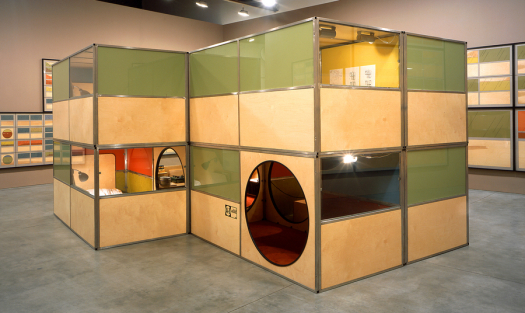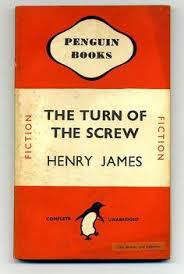Through their works A-Z Cellular Compartment Units and the Gramsci Monument Andrea Zittel and Thomas Hirschhorn explore how structures and specific spaces affect people and their way of living both physically and psychologically. Zittel’s A-Z Cellular Compartment Units comprises of architectural modules that are intended to be inhabited. The Gramsci Monument is also an architectural structure, but was created to act as a monument to commemorate an individual and to educate the public. Although the functions of these works vary greatly, both use an architectural approach to explore how art integrates with everyday life.
A-Z Cellular Compartment Units from 2001 consist of individual living space boxes that can be attached, stacked, and divided: customized for the dweller. Zittel herself lived in these units in October of 2001, modifying them to meet her daily needs, acting as a test subject for her own design, to explore the psychological and physical impact the units would have upon inhabitants (“Andrea Zittel…”). Zittel’s sculptures are formed by function, meant to be lived with and configured in ways to fit various necessities; Zittel calls this idea “living in abstraction,” what she defines as living in a way “so that anything can be anything” (Pedro). The Compartment Units follow this idea. Although a functional structure, the piece is a conceptual sculpture in the sense that Zittel explores how living spaces affect the mentality of the occupant. Compartmentalizing one’s daily habits into particular spaces is something that people already do in contemporary architecture: typical middle class houses separate rooms for eating, sleeping, and socializing. When certain actions that are meant to take place in specific rooms take place in another, there is a disconnect from normal daily habits. For a middle class family, eating dinner in the dining room rather than the kitchen may signify an important meal with family or guests, perhaps a holiday. The Compartment Units take this categorization of spaces to an extreme. In an interview with The Brooklyn Rail, Zittel addresses how her work is based on how it functions with life and living, as life matters more than art. She also comments that the “lifestyle industry” is based on commodifying and creating the illusion of living (Pedro). A-Z Cellular Compartment Units can perhaps be both. Although created with the intention of being a practical structure with intentions to function within everyday life, the design of the Compartment Units promote a lifestyle than is minimalistic and compartmentalizes daily activities into separate spaces, and therefore in practice would most likely be difficult or uncomfortable to live in.
 Andrea Zittel, A-Z Cellular Compartment Units. 2001.
Andrea Zittel, A-Z Cellular Compartment Units. 2001.
Hirschhorn’s Gramsci Monument from 2013 is similar to A-Z Cellular Compartment Units in that is an architectural structure with a purpose for those who interact with it. The Gramsci Monument is a structure that serves as a monument to Italian Marxist theorist Antonio Gramsci, whom Hirschhorn latches onto as inspiration due to his idea that “everyone is an intellectual” (Forster, Ravich). It is not a traditional monument in the sense that it has no permanence. Hirschhorn seeks to create a new type of monument and a new type of art by constructing a temporary monument that exists for only two and a half months in the Bronx public housing development of Forest Houses (“Investigation”). The monument itself is constructed of everyday household materials: plywood, staples, duct tape, and tinfoil; reflecting its ephemeral quality. The residents of Forest Houses served as the construction crew, and advised Hirschhorn in building the monument so that it would be structurally sound while meeting Hirschhorn’s wishes (“Investigation”). They were paid hourly for their labor, and the experience of building the structure brought many individuals together as a community. Although Hirschhorn is firm that his intentions for the monument were not to help the community but for the community to help the artwork, the work strengthens ties in the community by teambuilding in the planning and construction, and by the various daily and weekly activities that took place at the monument once construction was finished (Forster, Ravich). On site, there is a wifi station, library including the works of Gramsci, art workshops, readings and lectures in the theater: all elements that serve the community in education. Hirshhorn describes the collaboration with the Forest Houses residents on the Gramsci Monument an “unshared authorship:” both he and the community take credit for the entirety of the work (“Investigation”). Since the community of Forest Houses was essential to realization of the Gramsci Monument, it’s construction and ongoing activities changed the lives of the residence for the two and half months the monument existed: giving many work and educational opportunities. Even after the Gramsci Monument was taken down, it continues to live on in the collective memory of the Forest Houses residents.
 Thomas Hirschhorn, Gramsci Monument at Forest Houses. 2013. (photo: The New York Observer)
Thomas Hirschhorn, Gramsci Monument at Forest Houses. 2013. (photo: The New York Observer)
While both A-Z Cellular Compartment Units and the Gramsci Monument are both architectural structures with specific but very unalike purposes, the outcome of these works are much greater than their purposeful intentions. Zittel explores how, as a culture, people categorize and separate their lives into various tasks, and how this compartmentalization reflects in their living spaces. With the Gramsci Monument, Hirschhorn creates a new type of monument involving community, and although the structure itself is temporary, it creates a lasting impression on those involved with its construction and activities. Through these works, the intersection of art and everyday life makes clear that our culture is one that is truly post-medium.
Works Cited
“Andrea Zittel A-Z Cellular Compartment Units May 10 – June 15, 2002 Main Gallery.” Andrea Zittel – Exhibition – Andrea Rosen Gallery. Andrea Rosen Gallery, n.d. Web. 13 Mar. 2017. <http://www.andrearosengallery.com/exhibitions/andrea-zittel_2002-05-10>.
Forster, Ian, and Nick Ravich. “”Gramsci Monument” Thomas Hirschhorn.” Art21. Art21, 22 May. Web. 13 Mar. 2017. <https://art21.org/watch/exclusive/thomas-hirschhorn-gramsci-monument-short/>.
“Investigation.” Art21. Art21, 24 Oct. 2014. Web. 13 Mar. 2017. <https://art21.org/watch/art-in-the-twenty-first-century/s7/thomas-hirschhorn-in-investigation-segment/>.
Pedro, Laila. “ANDREA ZITTEL with Laila Pedro.” The Brooklyn Rail. The Brooklyn Rail, 4 Oct. Web. 13 Mar. 2017. <http://brooklynrail.org/2016/10/art/andrea-zittel-with-laila-pedro>.
Advertisements Share this:




